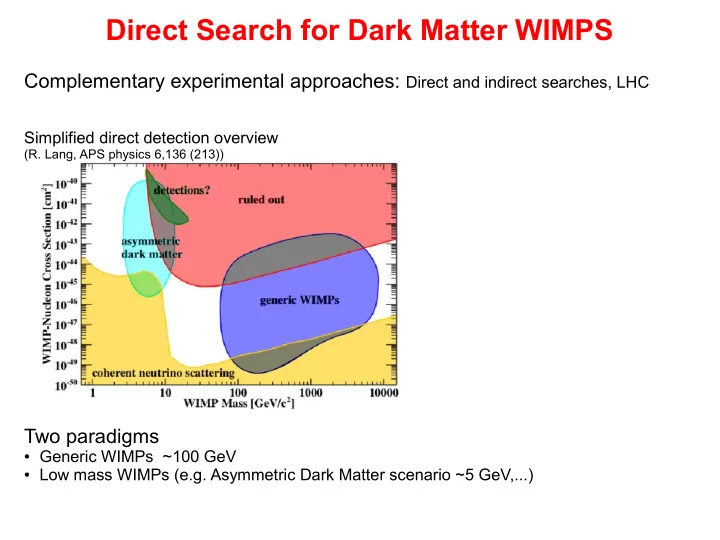

Direct Search for Dark Matter WIMPS Complementary experimental approaches: Direct and indirect searches, LHC Simplified direct detection overview (R. Lang, APS physics 6,136 (213)) Two paradigms ● Generic WIMPs ~100 GeV ● Low mass WIMPs (e.g. Asymmetric Dark Matter scenario ~5 GeV,...)
High Mass Frontier Strategy: Increase exposure no background ● “Natural” weak scale WIMPS 10 -9 -10 -10 pb /nucleon ● Irreducible neutrino background at 10 -12 pb from coherent scattering of atmospheric neutrinos Which detector technology ? ● Noble liquids probably most natural choice for ton scale detectors (Xe requires background improvement of a few 1000 to reach 10 -12 pb) ● Cryogenic detectors may also play a useful role for weak scale WIMPs Need a few 100 kg to reach 10 -10 pb/nucleon Complementary: Very different backgrounds and detection mechanism Different nuclei and experiments needed for confirmation of signal ● Several target materials are needed (isospin violating coupling)
Direct detection limits Snowmass Summary Report 2013 ● WIMP-nucleon cross section, assuming σ ~ A 2 to allow comparison of experiments ● Xe is dominating the high mass range (LUX ~10 -9 pb)
Low Mass Frontier expected recoil spectrum: Xe, 5 GeV WIMP Need excellent signal to noise – recoils mostly below 1 keV – threshold much more important than mass – kg scale detectors sufficient Which detector technology ? cryogenic detectors: – excellent S/N makes them most natural choice for low threshold CDMSlight: use Neganov-Luke and give up discrimination 0.176 keV ee / 0.84 keV nr threshold CRESST: 600 eV recoil threshold – detectors with light nuclei most useful CMDS Si CaWO 4 , Al 2 O 3 ?? Noble liquids: – Large uncertainty of recoil energy scale ( L eff , energy and field dependence of electric field quenching) – S2 only might be useful, no fiducialization, no convincing idea for calibration of recoil energy scale
Low Mass region Confusing situation: – Several hints and one claim (DAMA), excluded by others – Unsuspected backgrounds, systematic uncertainties in nuclear recoil energy scale ? – Isospin violating coupling may considerably relax tension (rate on nucleus depends on f n /f p , drastic reduction possible)
CRESST Present Run α and 210 Pb recoil background completely suppressed in all new types of detector modules (strongly reduced in conventional)
CRESST Present Run ● New self grown crystals (TUM) ~10 times lower β/γ background 179 Ta 179 Ta 181 W 181 W ● Energy resolution and accuracy of calibration at sub keV level ● Some detectors run at 0.6 keV threshold (lowest of all DM searches)
CRESST and Future ● Run for ~ 2 years and collect 2000 kg days of data ● Grow new set of radiopure crystals in Munich and prepare detectors modules of the new type and replace conventional ones as soon as possible ● R&D for detector modules with M>1kg. ● Upgrade CRESST set-up at Gran Sasso to house ~50 kg detectors ● Develop common tower structure for integrating CRESST type detectors in EURECA/SuperCDMS
Conclusion Detector technology pioneered at MPI with excellent potential for making a useful contribution in DM search, especially for low mass WIMPs Excellent energy resolution and perfect discrimination of alpha backgrounds at high energies makes this detector technology an excellent choice for a next generation of neutrinoless double beta decay searches (Federica's talk) Other attractive (high risk/high gain) applications in neutrino physics: Calorimetric measurement of electron capture in 163 Ho for next generation of direct neutrino mass experiments with sensitivity m ν < 0.1 eV
Recommend
More recommend